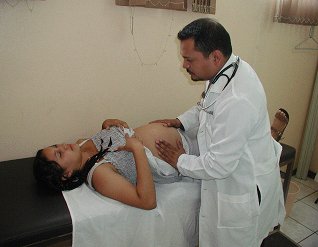The International Classification of Diseases (ICD) is a globally used diagnostic tool for epidemiology, health management and clinical purposes. The ICD is maintained by the World Health Organization (WHO), which is the directing and coordinating authority for health within the United Nations System. The ICD is originally designed as a health care classification system, providing a system of diagnostic codes for classifying diseases, including nuanced classifications of a wide variety of signs, symptoms, abnormal findings, complaints, social circumstances, and external causes of injury or disease. This system is designed to map health conditions to corresponding generic categories together with specific variations, assigning for these a designated code, up to six characters long. Thus, major categories are designed to include a set of similar diseases.

Prenatal care, also known as antenatal care, is a type of preventive healthcare. Its goal is to provide regular check-ups that allow doctors or midwives to treat and prevent potential health problems throughout the course of the pregnancy and to promote healthy lifestyles that benefit both mother and child. During check-ups, pregnant women receive medical information over maternal physiological changes in pregnancy, biological changes, and prenatal nutrition including prenatal vitamins. Recommendations on management and healthy lifestyle changes are also made during regular check-ups. The availability of routine prenatal care, including prenatal screening and diagnosis, has played a part in reducing the frequency of maternal death, miscarriages, birth defects, low birth weight, neonatal infections and other preventable health problems.

In a physical examination, medical examination, or clinical examination, a medical practitioner examines a patient for any possible medical signs or symptoms of a medical condition. It generally consists of a series of questions about the patient's medical history followed by an examination based on the reported symptoms. Together, the medical history and the physical examination help to determine a diagnosis and devise the treatment plan. This data then becomes part of the medical record.

Preventive healthcare, or prophylaxis, consists of measures taken for disease prevention. Disease and disability are affected by environmental factors, genetic predisposition, disease agents, and lifestyle choices and are dynamic processes which begin before individuals realize they are affected. Disease prevention relies on anticipatory actions that can be categorized as primal, primary, secondary, and tertiary prevention.
The National Center for Health Statistics (NCHS) is a principal agency of the U.S. Federal Statistical System, which provides statistical information to guide actions and policies to improve the public health of the American people.
A medical classification is used to transform descriptions of medical diagnoses or procedures into standardized statistical code in a process known as clinical coding.
The Current Procedural Terminology (CPT) code set is a medical code set maintained by the American Medical Association through the CPT Editorial Panel. The CPT code set describes medical, surgical, and diagnostic services and is designed to communicate uniform information about medical services and procedures among physicians, coders, patients, accreditation organizations, and payers for administrative, financial, and analytical purposes.

Screening, in medicine, is a strategy used to look for as-yet-unrecognised conditions or risk markers. This testing can be applied to individuals or to a whole population. The people tested may not exhibit any signs or symptoms of a disease, or they might exhibit only one or two symptoms, which by themselves do not indicate a definitive diagnosis.
This is a shortened version of the fifteenth chapter of the ICD-10: Pregnancy, childbirth and the puerperium. It covers ICD codes O00.0 to O99.8. All versions of the ICD-10, including the most recent one (2019), can be browsed freely on the website of the World Health Organisation (WHO). The ICD-10 can also be downloaded in PDF-form.
Oral medicine is a specialty focused on the mouth and nearby structures. It lies at the interface between medicine and dentistry.
Class R:Medicine is a classification used by the Library of Congress Classification system. This page outlines the subclasses of Class R.
This is a shortened version of the second chapter of the ICD-10: Neoplasms. It covers ICD codes C00.0 to D48.9. All versions of the ICD-10, including the most recent one (2019), can be browsed freely on the website of the World Health Organisation (WHO). The ICD-10 can also be downloaded in PDF-form.

The Alabama Department of Public Health is the primary state health agency of the government of the U.S. state of Alabama. It provides a number of public health services to Alabama residents.
The ICD-11 is the eleventh revision of the International Classification of Diseases. It will eventually replace the ICD-10 as the global standard for coding health information and causes of death. The ICD-11 is developed and regularly updated by the World Health Organization (WHO). Its development spanned over a decade of work, involving over 300 specialists from 55 countries divided into 30 work groups, with an additional 10,000 proposals from people all over the world. Following an alpha version in May 2011 and a beta draft in May 2012, a stable version of the ICD-11 was released on 18 June 2018, and officially endorsed by all WHO members during the 72nd World Health Assembly on 25 May 2019.
In a medical encounter, a past medical history, is the total sum of a patient's health status prior to the presenting problem.
International Classification of Diseases, 10th Revision, Clinical Modification (ICD-10-CM) provided by the Centers for Medicare and Medicaid Services (CMS) and the National Center for Health Statistics (NCHS), for medical coding and reporting in the United States. The ICD-10-CM is a morbidity classification for classifying diagnoses and reason for visits in all American health care settings. The ICD-10-CM is based on the ICD-10, the statistical classification of disease published by the World Health Organization (WHO) which replaces ICD-9.
A women's health nurse practitioner (WHNP) is a nurse practitioner that specializes in continuing and comprehensive healthcare for women across the lifespan with emphasis on conditions unique to women from menarche through the remainder of their life cycle.
An audiologist, according to the American Academy of Audiology, "is a person who, by virtue of academic degree, clinical training, and license to practice and/or professional credential, is uniquely qualified to provide a comprehensive array of professional services related to the prevention of hearing loss and the audiologic identification, assessment, diagnosis, and treatment of persons with impairment of auditory and vestibular function, and to the prevention of impairments associated with them."